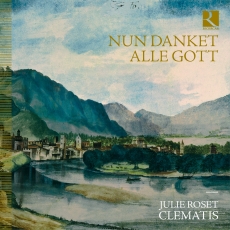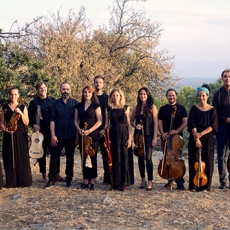Ensemble Clematis - Nun danket alle Gott - musica Dei donum
Claudio Monteverdi seems the odd man out in this programme of 17th-century German sacred music, especially as all the composers are from the Protestant part of Germany. However, there are two good reasons to include his Confitebor tibi Domine. The first is that Monteverdi could be considered the godfather of German sacred music of the 17th century, whether Lutheran or Catholic. That is to say: he clearly influenced the writing for solo voice(s), for instance in the oeuvre of Heinrich Schütz, the most notable absentee in this recording. He and his colleagues also composed music, which was rooted in the stile antico. of the 16th century, and many were also attracted to the polychoral writing which was a hallmark of Venetian sacred music of the 16th and early 17th centuries.
However, in this programme we hear only music for solo voice, accompanied by basso continuo and a small ensemble of strings. Monteverdi's setting of Confitebor tibi Domine is for soprano, two violins, two violas, bassoon and basso continuo. It is one of seven settings of this text. However, and that is the second reason to include this piece here, there are considerable doubts about his authorship. As most pieces performed here, it appears in the so-called Düben collection, preserved in Uppsala (Sweden), and comprising a large number of vocal and instrumental works from across Europe, many of them not known from any other source. Here it is attributed to Monteverdi. However, the same piece is also included in another important source, the Bokemeyer Sammlung, preserved in Berlin, and there it is attributed to Johann Rosenmüller. It is one of nine settings of this text from his pen. Jérôme Lejeune mentions the fact that the scoring of the bass line for bassoon rather than a bass viol was a practice of the late 17th century, which seems to point into the direction of Rosenmüller. However, Lejeune argues that, from a stylistic angle, it is hard to believe that this piece is not from Monteverdi's pen, and I tend to agree. I heard several things which reminded me of other works by Monteverdi, such as elements in the ritornelli and the flourishing ornamentation at the end of phrases.
Obviously, Rosenmüller had to be included, as among all German composers of his time, he was most strongly leaning towards the Italian style. He lived in Venice for a considerable part of his life, but even before his departure to Italy, his oeuvre shows the influence of the main masters from below the Alps. It is notable that the scoring of Ach Herr, strafe mich nicht is identical with that of Confitebor tibi Domine. A scoring for two violins and two violas (or viole da gamba) with basso continuo was common in Germany during the 17th century, such as in Ad te clamat cor meum by Augustin Pfleger. For the setting of the text, opening with the phrase "My heart cries ou to you", the composer makes use of a common rhetorical figure, the exclamatio. Christoph Bernhard does the same in Aus der Tieffen, a setting of the penitential psalm 130 (129). The scoring for soprano with two violins and basso continuo represents a 'modern' trend in German music. Bernhard had been in Rome, where he came under the influence of Giacomo Carissimi.
The programme includes two pieces by Andreas Hammerschmidt, a very productive and versatile composer of the generation after Heinrich Schütz. His music has been given some attention in the recent past, but the largest part of his oeuvre is still unknown. Jérôme Lejeune announces a Hammerschmidt disc by Vox Luminis, which is certainly something to look forward to. Here we get two pieces. Vulnerasti cor meum is a setting of a well-known text from the Song of Solomon; it is scored for solo voice and basso continuo. It shows strong similarity with comparable pieces by Schütz, who had a strong influence on Hammerschmidt. It is notable that Nun danket alle Gott has the same scoring as the pieces by Monteverdi and Rosenmüller. Hammerschmidt's setting ignores the melody of the hymn which was common in Germany and is still part of hymnbooks across the globe.
The cantatas by Dieterich Buxtehude are the bridge to the style which was to become common in the 18th century. The two cantatas included here are scored for two violins and basso continuo, with an additional viola in O clemens, o mitis, o coelestis pater. The latter includes a passage of a recitativic character.
In every piece, one notices the purpose of the composers to illustrate the text in their music. Rosenmüller's Ach Herr, strafe mich nicht is a brilliant example. He gives special attention to the word "erschrocken" (afraid). And "wie lange" (how long) is set to a very long note. The second section is considerably more emotional, and here the first violin gets involved, imitating the sighs of the voice. In the third section, the whole ensemble joines the soprano. This way Rosenmüller creates an eloquent increase in drama and urgency.
The pieces recorded here are pretty much a sampling of the many techniques composers of the time had at their disposal to depict a text. I am happy to say that what they intended - the expression of the affetti of the text - comes off very well in these performances. Julie Roset has a very fine voice, an excellent diction and a pretty good command of German, which are prerequisites for a convincing interpretation of this repertoire. Only now and then I would have liked a more declamatory approach and some more rhythmic freedom. The instrumental ensemble is the perfect partner, delivering colourful and dynamically differentiated support for Ms Roset. I also greatly appreciate the way the programme has been put together: only Bernhard and Buxtehude's Herr, wenn ich nur dich habe are among the more or less familiar items. That's a pretty good score, and makes this disc a nice and meaningful contribution to the catalogue of German sacred music of the 17th century.

